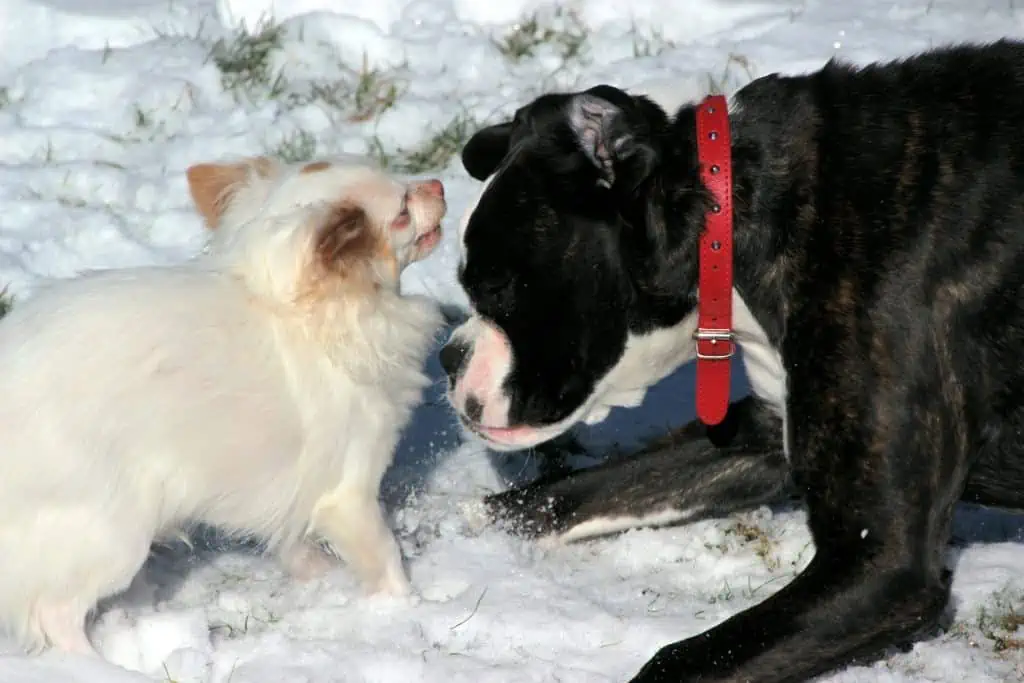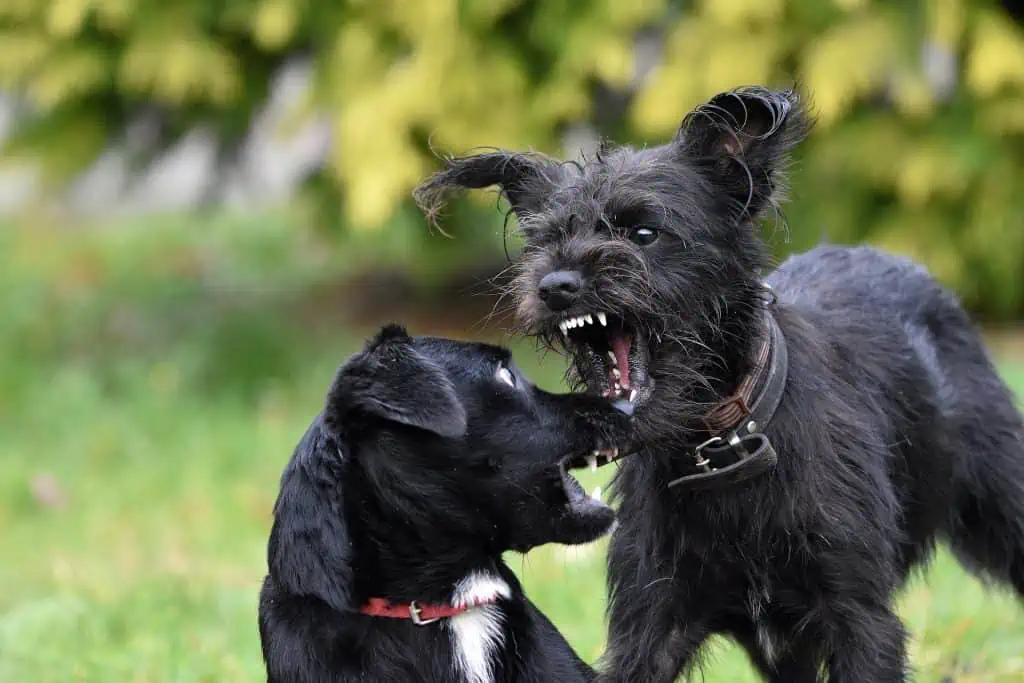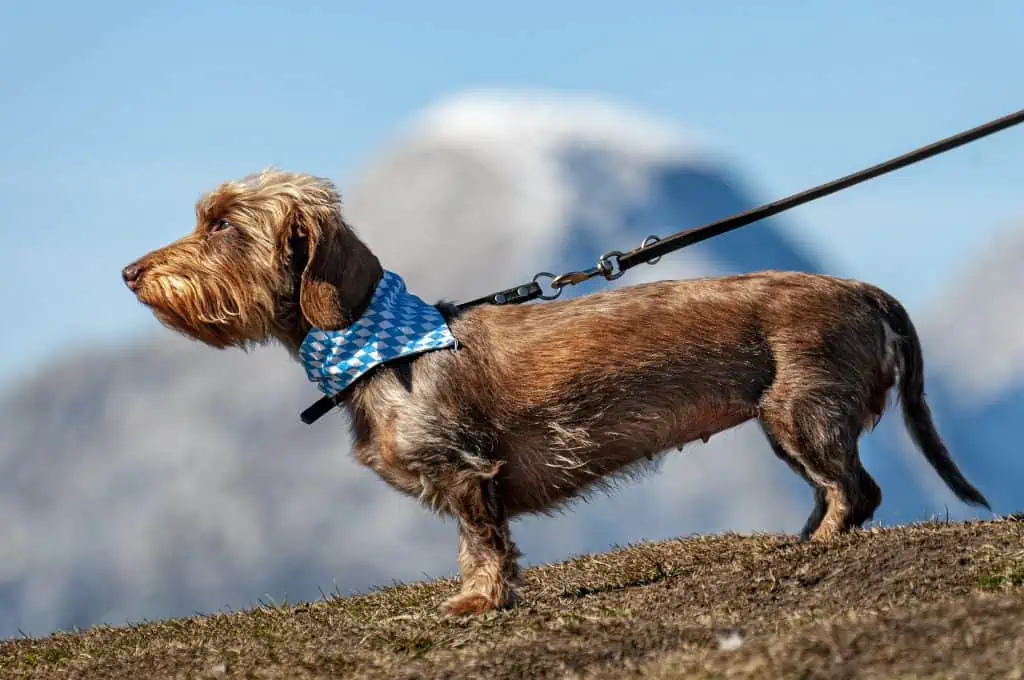Are you planning to buy a new dog, or have you brought one? You may think that introducing two dogs is not a big deal, that you just need to introduce the two dogs to each other, and they will automatically become friends. But that is entirely not the case when it comes to introducing two dogs. Most people don’t even know “how to safely introduce two dogs,” and they end up with their dogs toe to toe with each other.
Introducing two dogs is not a piece of cake. As humans, we don’t connect with others immediately, so why do we expect our lovely pets to bond as soon as they set their eyes on another dog? Here are some tips on what to do when you introduce two dogs.
Often, owners don’t even know “how to introduce two dogs safely,” so their dogs end up fighting.
Contents
Tips For Safely Introducing Two Dogs
Introducing two dogs safely and in a controlled environment isn’t everyone’s cup of tea. While many stress over it a bit too much, it’s not too difficult if you know what you are getting into.
Find a Neutral Place to Introduce The Dogs
To introduce two dogs safely, it is crucial to find a neutral place. A park or other open space is best because it will allow both dogs to run around freely and sniff each other in a safe environment. If you live in an apartment complex or condo building and want to introduce the dogs there, ensure there’s enough space for both dogs to run around and get comfortable with each other.
One of the most important things to consider to introduce two dogs safely is that the place you plan to introduce them should not be overcrowded and noisy. For example, introducing two dogs shouldn’t take place in a busy area such as a market or a mall or a hypermarket where there are lots of people, or other animals around that might distract them from getting along with each other. Noise phobia is prevalent in dogs. Your dogs can get panicked in a noisy place. It might become difficult to manage after that.
So, it’s better to find a peaceful and quiet place to safely introduce two dogs, where they are not disturbed by others. Some researches also show that dogs feel happier in crop fields.
Prepare Your Home if You Wish to Introduce the Dog to It
If you’re planning on bringing a new dog into your home, it’s essential to prepare before bringing them home. Your new dog needs a place to get away from his owners for some quiet time without feeling left out or abandoned. The best way to create this space is by giving him his bed, food bowl, and water bowl in a quiet room where he won’t be disturbed by other family members or pets. Preparing your home for your new dog is also critical for safely introducing two dogs. Otherwise, they may get jealous of one another.
To safely introduce two dogs, bringing extra dog food when you pick up your new puppy is essential. Puppies eat more than adult dogs, so expect your new puppy to eat all his food within a few days of coming home with you. If you don’t have any extra food on hand, consider buying a large bag of puppy chow before leaving for the pet store, so there are no delays when you get home with your new pup!
Second Meeting is the Best Time for the Introduction
When you get home from the shelter or a friend’s house with your new dog, bringing her out on the deck may be tempting to meet your current pet immediately. But it’s better to wait until your new dog has settled into her new home for a few days before introducing her to other animals in your home or on your property.
To safely introduce two dogs, when you introduce them, keep them separated by closed doors or baby gates at first so they can get used to each other’s scent and voice without actually seeing one another face-to-face. First, let them sniff under doorways and around door frames where their scents will be strongest. Let them see each other through the doorway and give them treats while they’re looking at each other, so they associate positive things with each other from the start rather than negative ones like barking or growling or lunging toward one another when they see one another later on.
Initially, keep two dogs separated by closed doors or baby gates to allow them to become accustomed to each other’s scent and voice without being exposed to each other’s faces.
Make Sure Both Dogs Are Leashed
It’s not easy to control a dog. Especially if it’s new, it’s advised to ensure both dogs are leashed. It will stop barking, but it’s easier for you to control them if one tries to get away. If they start fighting, you can separate them quickly and prevent them from harming each other. This precaution can help you introduce two dogs.
If they are not wearing collars, they won’t be able to run away when one of them starts barking at the dog approaching them first. And if there’s no leash in their mouths, neither of the dogs will easily attack the other one by surprise – because they won’t know what hit them! This way, both dogs will feel comfortable around each other and won’t get into trouble.
Moreover, dogs are less likely to fight and get out of control if they are leashed. If two dogs differ in size, it’s critical to ensure they are leashed and have collars. So before introducing the two dogs safely, make sure to leash them.
Make Sure Both Dogs Are Vaccinated
One of the most important things you should consider is safely introducing two dogs if you add a new puppy to your family; make sure it is up-to-date on all of his shots and that your resident dog has had them. Rabies is one of the most deadly diseases for dogs because it can be fatal if contracted by another animal. If you have an adult dog and don’t know if he’s been vaccinated, take him to the vet for a booster shot.
It’s better to make sure that both dogs don’t have rabies. It’s possible that your new puppy could have rabies (especially if he comes from an area where rabies is common), so make sure he gets tested before bringing him home.
You should also make sure that they don’t have viral infections. Dogs can pass around a lot of different viruses — including parvo and kennel cough — so be sure both dogs are healthy before bringing home a new pup.
If you can’t afford veterinary care, look into low-cost clinics or spay/neuter programs in your area that offer discounted services for low-income families or those adopting pets from shelters or rescue organizations. This step will not only ensure the health of your dogs and a good introduction but also prevent you from contagious diseases. Making sure that both dogs are disease-free is also helpful in safely introducing two dogs.
Observe Body Language
If you are a newbie, it’s better not to introduce two dogs. You should seek professional help because you might not be able to judge the dogs’ body language. When introducing two dogs, it’s essential to pay attention to their body language and watch for signs of aggression. If both dogs are friendly and relaxed around each other, then it’s okay for them to meet face-to-face. If one of them seems uncomfortable or aggressive in any way, wait to force them to interact until they become more comfortable around each other. When they are forced to interact, they fight.
Accordingly, research signs show that both dogs are welcoming of each other if they are
- Wiggling their hind ends.
- Relaxed facial expressions.
- Play bows.
- Wagging their tails fast
We assume a dog’s personality by looking at their sizes, but it’s wrong. Don’t make assumptions about their personalities based on breed or size. Every dog is born with a different one. Your small Chihuahua, for example, maybe more aggressive than your Golden Retriever!
The best way to introduce two dogs is by keeping them separated at first so they can get used to each other’s presence without having to worry about being attacked. This way, they’ll also learn what it feels like when another dog comes near them.
Keeping two dogs separated at first allows them to get used to each other’s presence without worrying about being attacked. As a result, they’ll also learn what it’s like to be near another dog.
Take Off Leashes & Let Them Interact
When introducing two dogs, it is important to make sure they are comfortable with each other before you let them interact. If both dogs show positive body language and do not appear to display a dominant or submissive position, take off their leashes. Let them interact for a little while and then see how they respond to each other.
If both dogs show negative body language when interacting, take them home and keep them separated for at least 24 hours. Then slowly reintroduce them into your life together over the next few days until you are sure that both dogs are getting along well with one another.
Take The Dogs for a Walk
Taking your dogs for a walk can also be a good step for introducing them safely. Start with two or three short walks of no more than 15 minutes each. Let your dogs sniff each other, play, and walk together until they are comfortable with each other. Then, increase the time spent walking together and add another dog.
Once comfortable with two or three short walks, take your dogs on long walks in the same direction. That will help prevent accidents from happening as much and give both dogs time to get used to being around each other without having them run into each other.
Once you’ve gotten comfortable with walking together, try walking one dog at a time in the opposite direction for a few minutes each day. This will help teach the dogs where their boundaries are so they don’t accidentally step on each other’s feet when they aren’t expecting it!
Make Sure Both Dogs are Spayed
The most important thing to avoid any bad scenario while introducing two dogs is to ensure both dogs are spayed. Spayed dogs can’t get pregnant, and their hormones will not cause aggression or jealousy, so it’s much easier for them to get along with other dogs who are also spayed. If your dogs aren’t spayed, they may get aggressive and make it difficult for you to control them.
There should be extra care if you are introducing a female dog to a male dog and they are of different breeds. You may also want to consider neutering your male dog before introducing him to your female dog. This will eliminate the risk of accidental conception, and mixed breeds can be harder to manage because they don’t have the same instinctual behaviors as purebreds.
Be Ready for Bad Scenarios
No matter how well you know your dog and how much you’ve prepared, bringing home a new dog is always an uncertain process. Your dogs may love each other right away, or they may not. They may get along fine, but there’s also a chance that one of them will react badly to the new addition. You need to be ready for the worst scenarios and be able to act quickly if something goes wrong.
If one of them is aggressive or dominant, it could lead to serious injuries or even death for one of the dogs involved in the fight. If one dog is small enough, it could even be killed by its larger companion if they fight too hard — especially if they end up in the water during its scuffle.
Unfortunately, if you face such a situation, immediately separate both dogs. Take the injured dog to the vet. And don’t try to introduce them again anytime soon.
Dogs involved in a fight may suffer serious injuries or even die if one of them is aggressive or dominant.
Be Patient
When introducing two dogs, it’s important to remember that they are not human beings. They don’t know what you want them to do or how you expect them to act. Take your time during the introduction and be patient with both of them. If one of them acts aggressively towards the other, just ignore them until they calm down. Don’t try to pull one away from the other because this could make things worse by making them fight for dominance or prevent them from getting along later in life when they finally become friends.
Be Consistent
If you don’t want your dogs to fight with each other or become jealous of one another, you need to be consistent when introducing them. Put their food bowls next to each other for them to get used to one another’s presence at mealtime. Make sure that both of their toys are kept in the same place so they can share their belongings without feeling threatened by one.
Don’t Rush
Introducing two dogs takes time, so don’t rush it. They might become anxious or defensive if you’re trying to get them acquainted with each other too fast. That could lead to aggressive behavior and fights between them.
It will take time for them to make their introductions on their terms. Make sure you give them enough space and time before trying to force them into one space or room where they can see each other. Don’t try to forcefully make them comfortable with each other unless you want something wrong to happen, like aggression or fighting!
Don’t expect instant results from introducing two dogs because it will take a while (or a few weeks).
Common Mistakes People Make While Introducing Two Dogs
Following are the mistakes people make while introducing two dogs.
Introducing a High-Energy Dog With a Low-Energy Dog
One of the common mistakes is not taking into account how much energy a new dog has. Introducing a high-energy dog to an older dog that has just been through surgery may result in the older dog not being able to keep up with the younger one, resulting in injury to both dogs.
Ignoring Body Language
Another bigger blunder is ignoring body language during introductions. Suppose one or both of the dogs show signs of stress or fear, such as panting heavily, lowering their head and tail between their legs, or rolling on their backs. In such cases, it’s best to stop the introduction for a bit and try again later when there are fewer distractions around them (e.g., children playing) so that they have more chance of paying attention to each other rather than what’s happening around them.
Leaving Both Dogs Unsupervised
You cannot leave them unsupervised right from the start since this may lead to fights, and fights can lead to injuries or even the death of one of your pets. Therefore, you should always keep an eye on them while they are playing together so that you can stop any fight immediately before it starts.
Unsupervised pets can cause fights, and fights can lead to injuries or even death, so you should never leave them unsupervised right from the start.
Not Letting the New Dog Smell Around
Letting the new dog smell around the house and making sure it doesn’t interact suddenly with the other dog is the key to a successful first interaction. Therefore, make sure that your new dog gets familiar with her new surroundings by sniffing everything around so that she feels at home here.
Not Training Both Dogs Simultaneously
This is one of the biggest mistakes people make when trying to train their new dog and integrate him into their current pack. They may put all their efforts into training the new puppy and then expect him to automatically get along with the other dog in their home. And while this can sometimes happen, chances are high that it will only go smoothly if you take the time to train both dogs together from day one!
| Dos | Don’ts |
| Find a neutral place | Forcing the dogs |
| Introduce in separate spaces | Not observing the body language of dogs |
| Prepare the place | Not training both dogs at the same time |
| Make sure to leash both dogs | Rushing in introducing dogs |
| Observe body language | Ignoring rabies and other diseases |
Wrap Up
Introducing two dogs safely requires patience, consistency, and a keen eye for detail. The key to a successful introduction is to start in a neutral place, such as a park or quiet area, where both dogs can feel at ease. If you choose to introduce the dogs in your home, make sure to prepare the space beforehand. This may include bringing extra food and setting up a separate area for the new dog.
Before introducing the dogs, make sure they are both wearing collars and leashes. Place them in crates and allow them to sniff and smell each other. Observe their body language closely and pay attention to any signs of discomfort. If they seem comfortable with each other, you can take off the leashes and let them interact. Remember to be prepared for any potential negative scenarios, and never force the dogs to interact if they are not ready.
It’s also important to note that certain combinations of dogs should be avoided when introduced. For example, two dogs of the same sex and breed may not get along well, and introducing a puppy to an adult dog can also be challenging. By following these guidelines and remaining vigilant, you can successfully introduce two dogs and lay the foundation for a happy and harmonious relationship.

Jen Jones is a professional dog trainer and behavior specialist with more than 25 years of experience. As the founder of ‘Your Dog Advisor’ and the ‘Canine Connection’ rehabilitation center, she applies a holistic, empathetic approach, aiming to address root causes rather than merely treating symptoms.
Well known for her intuitive and compassionate approach, Jen adopts scientifically-proven, reward-based methods, encouraging positive reinforcement over punishment. Jen specializes in obedience training, behavior modification, and puppy socialization. Her innovative methods, particularly in addressing anxiety and aggression issues, have been widely recognized. Jen has worked with many of the world’s leading dog behaviorists and in her free time volunteers with local animal shelters and rescue groups.






